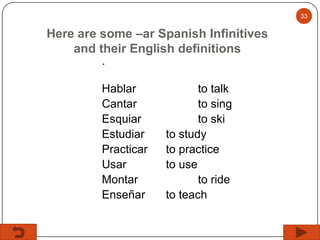

While this is true, the verb Ver is also one of the most important verbs to know because it’s so common. Whether it’s the imperfect tense, present indicative, present subjunctive, the past participle, or the preterite tense, the verb Ver takes some getting used to. It’s one of those irregular verbs that doesn’t seem to follow any Spanish grammar rules at all. The irregular verb Ver is one of the most difficult verbs to memorize. This way, we will say “ Yo con duje, Él con dujo, Ellos con dujeron” and so on.You might have noticed that Spanish conjugations tend to be difficult, especially in the preterite tense. Verbs ending in -DUCIR: when the verb ends in -DUCIR just like “ traducir, conducir, deducir“, then we will replace -DUCIR for -DUJ for all subject pronouns, and add the conjugations in the second picture presented above.Verbs ending in -CAR: when verbs end in -CAR just like “ buscar, dedicar, educar, enfocar, explicar, sacar, secar“, then we will replace that ending for -QUÉ for the pronoun YO only, as in the sentences “Yo busqué la billetera.”.Verbs ending in -GAR: when verbs end in -GAR in their infinitive form just like: “abrigar, agregar, ahogar, albergar, apagar, colgar”, the verb will be conjugated differently for the first person (the pronoun YO), so we will replace -GAR for -GUÉ as in the sentences “Y o pagué las cuentas” and “Yo colgué la ropa“.For the pronoun “YO”, the -IR part will be replaced by “Í” with tilde as in “Yo concluí” and for “ÉL” and “ELLOS”, we will add the consonant “y” as in “Él construyó” and “Ellos cayeron”. Verbs with two vowels in their ending: verbs like “ leer, oír, concluir, incluir, constituir, construir, disminuir, fluir, poseer, caer, huir” suffer a spelling change for the pronouns YO, ÉL and ELLOS.There are many other irregular verbs and special cases in the past tense in Spanish besides the above-mentioned.: Other special cases in the preterite in Spanish SER: Yo fui, tú fuiste, él fue, nosotros fuimos, vosotros fuisteis, ellos fueron.

The following picture explains how we must change the verb’s stem and follow two different patterns depending on the new stem: Other irregular preterite verbs in Spanish following the pattern above, with a possible variation for “ELLOS”, are: “andar (anduv-), caber (cup-), decir(dij-), haber (hub-), poner (pus-), querer (quis-), saber (sup-), tener (tuv-)”. Take a look at the following chart and notice that the endings are different to those of regular verbs, but they stay the same for this particular group of irregular verbs: “estuv-” for the verb ESTAR, and then remember the new endings that may apply only to them and a few other verbs. For this group of verbs, first you must memorize their stem in the past, e.g. There is a particular group of verbs that are commonly used in the language, but they suffer stem changes as well as changes in their ending, that is, they won’t follow the rules presented above. Verbs with irregular stems and endings in the preterite tense Recognizing irregular preterite verbs in SpanishĪ lot of the verbs that are considered irregular in the present tense will also be considered irregular in the past tense in Spanish, including verbs like “caber”(to fit), “dar”(to give), “poder” (be able to), “saber” (know) and others. Keep two things in mind first, the endings used for –ER and –IR verbs like COMER and ABRIR are identical, and second, the conjugations for the pronouns YO, ÉL, ELLA and USTED in the preterite tense will always use a tilde over the last vowel for regular verbs. Know that you will also find irregular verbs in the past tense.Īs you can see in the chart below, the stem of regular verbs in the past tense in Spanish will not change at all for most verbs, only their ending. Verbs in the preterite tense in Spanish will change just the same way verbs in the present tense do, depending on the subject of the sentence. Just like in English, the preterite or past tense will be used for actions that happened at some time in the past and have already finished. We can refer to the past tense in Spanish as “ El pretérito perfecto simple”, “El pretérito indefinido” or simply as “El pasado simple”. Let’s start… The past tense of regular verbs in Spanish As usual, you will find simple explanations, many examples of sentences and interactive quizzes to test yourself. In this lesson, we will learn the basic rules to conjugate both regular and irregular verbs in the preterite tense in Spanish properly. In everyday interactions, it is very common to find ourselves talking about past events in Spanish, things that happened recently or a long time ago.


 0 kommentar(er)
0 kommentar(er)
